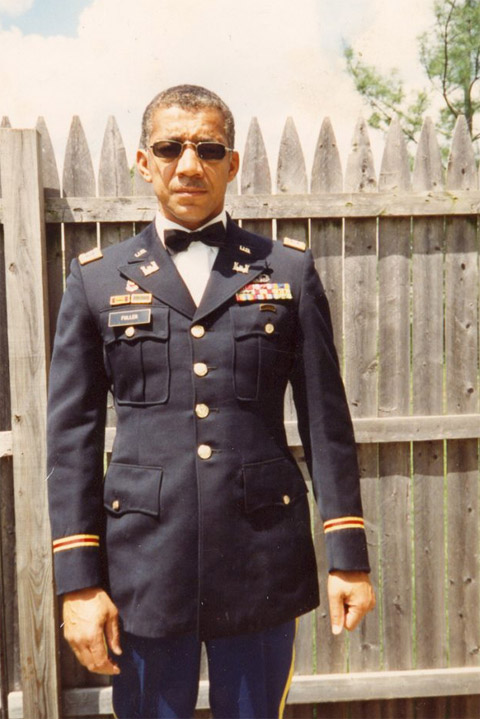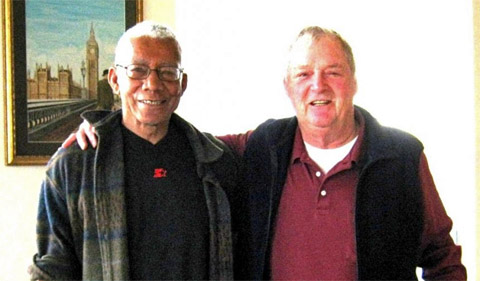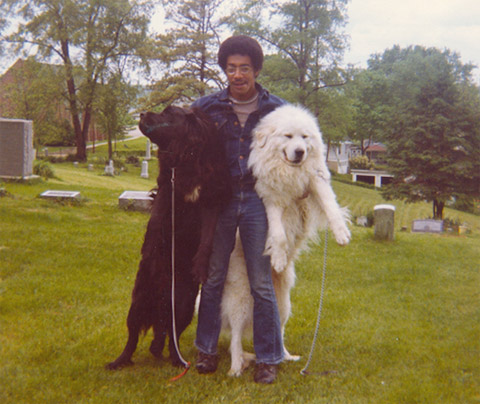
Lt. Col. Fuller in 1990, U.S. Army retirement day. He retired from the U.S. Army following nearly 23 years of active military service.
Lt. Col. Clark Fuller (ret.) (’75) earned his M.A. in Geography from Ohio University. In this article, he reflects on how his education and military experience helped shape his career.
by Lt. Col. Clark Fuller
In 1971, I was a career Army officer (rank of captain) who had relatively recently returned from a one-year combat tour in Vietnam. The military was offering me a two-year opportunity to complete a master’s degree program at Ohio University—to be followed with a three-year assignment to the faculty of the U.S. Military Academy at West Point, NY. I accepted the offer.
I arrived on the OHIO campus in December 1971 as a non-traditional student, and it didn’t take long for me to lose sight of my academic mission—I discovered Court Street! Court Street offered many tempting distractions for students. To me, the distractions were a welcome and interesting relief from what now, was a distant memory of jungles, rice paddies, and mountains of SE Asia. Cold cans of Rolling Rock beer and tall glasses of Harvey Wallbanger cocktails drowned out all those memories. With all the discipline and rigid rules of the Army now temporarily behind me, I marveled at finding out that civilian life could really be THIS good! Wow! (Plus, the military was still paying me my full pay and allowances while pursuing my degree, so this assignment, to me, was equivalent to a “bird’s nest on the ground!”)
After six months, I awakened to reality and realized that I was in deep, deep trouble. A lot of time had passed, and the Geography Department was not kidding when it came to maintaining its qualifying rules for completing a graduate degree. I had been ignoring them all along. Panic set in. I made contact with the Army and tried to bail out of my OHIO/West Point commitment. (I even made an offer to return to Vietnam!). No dice. The Army wouldn’t have it. Then (to my relief), one of the Geography Department. faculty—Dr. Lynden S. Williams, a military veteran who had served with the 82nd Airborne Division—agreed to take me under his wing and became my academic and thesis adviser. With a lot of counseling, focus, and hard work, I finally completed my master’s degree at OHIO in January 1975 and went on to teach physical and cultural geography to cadets at West Point. I owe all of my subsequent career success to Dr. Williams and to other OHIO Geography Department faculty for “guiding me to the light” during my tough, two years of lessons learned at Ohio University!
Memorable Milestones
My fulltime working employment spanned 46 years. Twenty-three years were devoted to military active duty while serving in the U.S. Army. I retired in 1990, and another 23 years were spent as a staff member employed at Ohio’s Central State University (CSU). I retired, once again, in 2013.
A memorable milestone achieved while in the Army was to reach the field-grade officer rank of lieutenant colonel. And a significant milestone achieved while working at CSU was to have developed and led many student-involved humanitarian assistance and economic development programs in Sub-Saharan Africa.
While in the Army my primary specialty was “Combat Engineer,” and my secondary specialty was “Foreign Area Officer” with a focus on Sub-Saharan Africa. Both specialties required honed leadership skills and proficiency in specified technical fields. I attained those skills through formal military training at different military schools—including Civil Engineering, Ranger, Airborne, Jungle Expert, and Command and General Staff schools in the U.S. and Panama. I achieved and mastered additional proficiency while assigned to challenging positions in Vietnam, Germany, and Korea, and several temporary assignments in Central America, Africa, and the Middle East. A former Army commander of mine (then assigned to the Pentagon) needed to fill a geography position at West Point. Knowing of my geography background and my time in Vietnam, he cleared the way for the assignment.
During my 23-year employment at CSU, I was responsible for developing and acquiring funding for programs that would support the institution’s international goals—especially those within the Departments of Manufacturing Engineering, Foreign Languages, and the International Center for Water Resources Management. Responsibilities not only involved writing funding proposals, but also leading, administering, and validating those same programs/projects once they were funded. Over the years, I spent many, many weeks overseas, especially in West Africa. I landed this civilian job because a former military commander knew of my geography and international background and had personally recommended me to the university president.
Thinking Back Fondly on OHIO
A Geography Department graduate seminar, titled “Latin America Culture and Physical Geography,” taught by Dr. Williams, led me to several research trips to Belize and eventually morphed into a topic for my master’s thesis, “Peoples and Hurricanes: A Study of Attitudes in Belize.” When I graduated and departed OHIO in 1975, I understand that Dr. Williams and Dr. Bob Walter, Department of Geography, continued to take groups of OHIO students to Belize for the continued exploration of myriad geography-related topics.
Two OHIO Geography professors, Dr. Frank Bernard and Dr. Walter, developed a state-of-the art multimedia presentation entitled, “Africa: A Multi-Media Presentation.” This attention-grabbing showcase was a combination of visuals and music put together in a way that captured Africa’s history, culture, and physiography in a manner that could not have been duplicated in a lecture setting. In fact, I introduced and shared this same innovative teaching tool with other faculty once I arrived at West Point. Within the Department of Earth Space and Graphic Sciences (ES&GS), we strived to create a similar inspiring series of presentations.
First-Rate OHIO Mentors
The following OHIO Geography professors (and their interactive areas) were highly instrumental in preparing me for my further work career, and who have made an impression that will last a lifetime:
- Lynden Williams: Thesis (Committee Chair); Active Mentor & Advisor; Geography of Latin America; Belize Research
- Hubert Wilhelm: Thesis; Cultural Geography
- Bob Walter: Geography of Africa; Belize Research
- Frank Bernard: Geography of Africa; Environmental Geography
- Ron Isaac: Thesis, Meteorology; Quantitative Methods
- Nancy Bain: Research Methodologies; Geographic Thought
- Hugh Bloemer: Cartography; Transportation Geography
There is no doubt that the cultural geography courses I took at OHIO, especially the courses regarding Africa, Asia, and Latin America, certainly helped prepare me for my eventual military and civilian assignments that required travel and assignments in places like Korea, Indonesia, Honduras, and many countries all over Africa.

Fuller with the late Geography Professor Lynden Williams in Buhl, Idaho, 2017. While on a road trip to California, Fuller made it a point to stop over at William’s home in Idaho to reunite and reminisce.
Further, knowing that I had a forthcoming assignment to teach at West Point when I finished my geography graduate degree I was allowed me to do some non-remuneration graduate student teaching for a couple of laboratory courses. That opportunity was an excellent “on-the-job” training initiative that very much helped to improve my instructor skills.
However, what REALLY stands out was the Geography Department’s requirement for each graduate student to complete a master’s thesis. Although the requirement was intimidating, time-consuming, and stressful, the experience ended up serving me well during my subsequent employment tracks.
For example, in 1981 I had just been assigned to the National Security Agency (NSA) located outside Baltimore, MD. I was to serve as an Army Foreign Area officer for security threat analysis focused on Africa and the Middle East. On my first project, I immediately found myself leading the production of a highly classified, multi-agency document regarding a possible Middle East/Persian Gulf air threat scenario. (The multi-agencies included NSA, CIA, USAF, U.S. Army intelligence entities, as well as civilian contractors, among others). There was a 12-month deadline for completion.
The tools I had learned while at OHIO to become organized, work collectively, perform research, and to write correctly towards producing an acceptable master’s thesis were instrumental in my producing a finished classified product on time.
During the 1990s, while employed as a civilian at Central State University, I was responsible for coordinating and escorting groups of students and faculty to West Africa for the purpose of completing water and economic development projects funded by USAID, Dept. of Energy, Dept. of Education, NASA, and others. Knowing how to arrange and deal with student groups in a foreign environment was critical. I had learned many critical techniques for accomplishing a successful foreign travel/living mission for student groups when I participated in a couple of student group travel trips to Belize organized by OHIO’s Geography Department in 1971-1975.
A Well-Rounded Education in Arts & Sciences
If I had not scrambled to get back into college after I was drafted by the Selective Service way back in 1964, I would probably have ended up becoming a retiree “old guy” somewhere, working at a local car wash or newspaper stand, striving to make financial ends meet.
Nonetheless, setting aside the financial implications, my having earned an Arts & Sciences degree in geography placed me ahead of many of my military counterparts, especially in terms of being able to better understand people and cultures while preparing war planning operations/missions destined to take place in foreign territories. This was very apparent to me when I was attending various military service schools.
Also, as a civilian with an advanced geography degree, I relish the times when I find myself among a group of professional colleagues who spin myths and non-scientific hearsay regarding such diverse topics as global warming, origins of the universe, climate change, declining oil reserves, overpopulation, renewable energy, human migration, aardvarks, the price of cabbage, etc. These colleagues appear much surprised when a “geographer” can chime in and provide scientific facts to support or debunk almost any position on almost any topic. So much for thinking that geographers can only focus on naming the capitals of states and countries!
Highlights of Living in Athens, Ohio
Because OHIO is located in a rural, small-town setting, residents and college students have access to a number of outdoor hiking, exploring, and recreational programs and activities. During my two years at OHIO, I managed to live in three different farmhouses scattered around rural Athens County. It is too bad that most graduate students don’t have enough free time to experience all that the Athens region has to offer. But finally, after 46 years of military and civilian careers, I retired in 2013 and made some return vacation visits to Athens to experience Strouds Run, Dow Lake, The Ridges, and other places in and around the area for the first time! I guess I really missed a lot in the early 1970s. There certainly IS more to Athens than just Court Street!

Captain Fuller and his two dogs in Athens, Ohio, 1973. “While I was an OHIO graduate student in the early ’70s, the unpopular war in Vietnam was still raging, and it was more advantageous to set aside the military uniform and dress local, including growing long hair!”
I would be amiss if I didn’t mention the company of four fellow graduate students in Geography who were also studying at OHIO in the early 1970s: Gary Haynes, Patricia Kolenic, Dennis Houmard, and Analeyam Marcos. We provided each other much-needed stress relief while mutually sharing our thesis horror stories at the Rathskeller in the basement of Baker Student Center. Our friendship was a very important and valuable morale booster for each of us in order to stay focused!
Valuable Advice for Current OHIO Students
My advice would be, “Stay close to those you have known during your college days, including all your professors and your close academic colleagues.” A graduate degree and résumé might be the ticket to landing a first job, but I firmly believe that having an edge will go a long way in trumping the crowd of competing graduates who have similar résumés and are looking to land the same jobs. That edge is having somebody on the inside who can help promote your chances for success.
Over the course of your career, you will find that many of those you have interacted with and known over the years may have gone on to high places and can be a valuable resource to help you capture your dream job. So don’t disregard your colleagues when you graduate. Forty-eight years after graduation, I still have a strong relationship with my OHIO student/professor “Belize Buddies!” Our continued relationship has served me well, both personally and professionally.
Seeing the Wide World
From a geographer’s perspective, if you’re going to talk the talk, you’ve got to walk the walk. Here are some ways that I’ve tried to follow that philosophy:
- In 1976 I took a month’s leave from the Army and backpacked through six countries in West Africa.
- In 1978 I took another month’s leave from the Army and hitchhiked across the Sahara Desert.
- The Vietnam War ended in 1975, but when I retired from the Army 15 years later (1990), I immediately made a solo return to Vietnam’s war zone to try to settle in my own mind—at my own terms, risk, and expense—just what America’s strategy and sacrifice was really all about when I was there during the 1960’s. People in foreign places are actually just like us, with similar needs and similar ambitions, if we would just stop and try to understand them. That solo return was a personal eye-opener for me!
The U.S. Air Force flies all over the world, and military air travel (mostly on cargo, refueling, and military duty passenger flights) is open for active and retired military personnel at practically no cost. During my employment years, I utilized those perks to reach places like Hawaii, Australia, New Zealand, Tahiti, American Samoa, Indonesia, the Philippines, Ascension Island, Zaire, Liberia, and many places in Europe. However, due to unexpected delays, detours, and mission cancellations, it requires a lot of patience and grit, but it can also be a geographer’s dream. I never did make it to Antarctica or Greenland—yet!
Finally, in my adult years, I have tried to make it a point to do a road trip within each of America’s fifty states. I have toured 49 states to date, with only Alaska to go!



















3 Comments